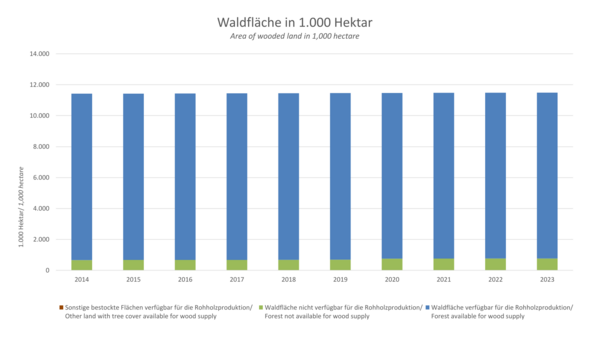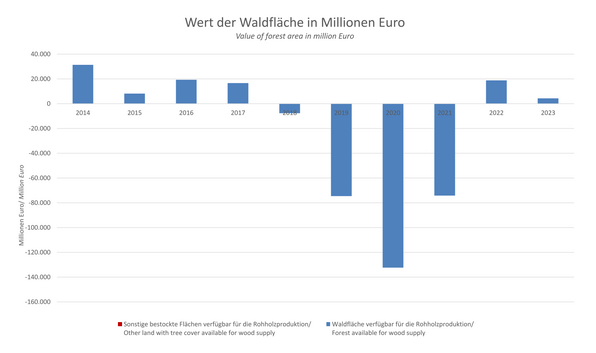The physical forest area balance in EFA Table A 1a represents the total German forest area in the respective reference year as well as the agricultural area used for the production of wood. The area is differentiated into the following categories
| 1. | Forest available for wood supply (forest area AWS) |
2. | Forest not available for wood supply (forest area NAWS) |
| 3. | Other wooded land (not relevant in Germany) |
| 4. | Other land with tree cover available for wood supply (including, e.g., agroforestry areas and short rotation plantations). |
Further, changes of forest area due to e.g. afforestation and deforestation are depicted in EFA-table A 1a. The statistical reclassification accounts the transition of forest area AWS to forest area NAWS.
In EFA-table A 1b, the value of the forest soil without tree stock is shown for forest area AWS and for other land with tree cover available for wood supply.
Forest area change in Germany since 1987, subdivided into afforestation, deforestation and forest land set-aside:
Forest land set-aside may arise, inter alia, by designating national parks, biosphere reserves or Natura 2000 areas, and reference areas for certification.
Publications
- Seintsch B, Englert H, Dieter M (2020) Kalamitäten führen zu forstlichem "Rekordergebnis" : Ergebnisse der Forstwirtschaftlichen Gesamtrechnung 2018: Großer Produktionswert und hoher Unternehmensgewinn. Holz Zentralbl 146(27):506-507 PDF Dokument (nicht barrierefrei) 1884 KB
- Rosenkranz L, Englert H, Seintsch B (2019) European forest accounts for Germany - Quality of data bases and accounting methods. Allg Forst Jagdzeitg 190(1-2):31-52
- Rosenkranz L, Englert H, Seintsch B (2018) Die Bewertung des Holzvorrats in der Waldgesamtrechnung. AFZ Wald 73(23):11-13 PDF Dokument (nicht barrierefrei) 216 KB
- Rosenkranz, L (2018) Produktionswert der Forstwirtschaft leicht rückläufig. Ergebnisse der forstwirtschaftlichen Gesamtrechnung 2016. Holz-Zentralblatt 144 (17): 393
- Rosenkranz L, Englert H, Jochem D, Seintsch B (2018) Methodenbeschreibung zum Tabellenrahmen der European Forest Accounts und Ergebnisse der Jahre 2014 und 2015: Abschlussbericht Teilprojekt 3. 2. revidierte Fassung. Braunschweig: Thünen-Institut, 86 p
PDF Document
Contact person - staff member
Dr. Lydia Rosenkranz

Institute of Forestry
Leuschnerstraße 9121031 Hamburg-Bergedorf
- Telephone
- +49 531 2570 1707
- lydia.rosenkranz@thuenen.de
Scientist











